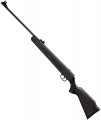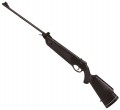Muzzle velocity
The muzzle velocity provided by the rifle - that is, the speed of the bullet as it exits the barrel.
All other things being equal, a higher bullet speed provides greater range and accuracy, and also simplifies aiming at long distances: the bullet flies along a smoother trajectory and requires fewer adjustments in height, and the influence of side winds decreases with increasing speed. On the other hand, this indicator directly affects the price of the rifle; and in some countries, legal restrictions on the ownership of pneumatic weapons are also related to the muzzle velocity of the bullet.
As for specific values, in the weakest modern rifles the initial speed does not exceed
150 m/s, and in the most powerful it can be
300 - 350 m/s or even
more(remember, the speed of sound is 330 m/s). In general, for recreational shooting at short distances, this parameter is not particularly important, and detailed recommendations for choosing pneumatics for more specific situations can be found in special sources. Let us only note that in AEG electric drives (see “Type”) the initial speed extremely rarely exceeds 150 m/s, but this is done solely for safety reasons: such “weapons” are intended for military-tactical games and initially involve shooting at people, and the high speed would be unsafe for players even with protective equipment.
It is also wor
...th considering that this indicator is not strictly defined. In any type of pneumatic it depends on the weight of the bullet (the lighter the faster); therefore, in the characteristics it is usually customary to indicate a certain average velocity for standard ammunition (usually weighing 0.5 g, in AEG - 0.2 g). In addition, in multi-compression rifles the actual speed of the bullet is determined by the degree of inflation, in gas-cylinder rifles it is determined by the ambient temperature, and in PCP models it is possible to achieve higher speeds than declared by replacing the air with a special gas (for example, helium). Nevertheless, this characteristic makes it possible to evaluate the capabilities of the rifle and compare it with other models, including those that differ in type.Muzzle energy
The muzzle energy provided by the rifle.
Muzzle energy is the kinetic energy of the bullet at the exit from the barrel. This energy, in turn, depends on two factors: the mass and the muzzle velocity of the bullet. Thus, this indicator directly describes the overall power of the rifle: higher muzzle energy allows you to effectively fire at longer distances and/or heavier ammunition. On the other hand, an increase in power accordingly affects the cost of weapons.
Note that muzzle energy can be grounds for legal restrictions on the purchase/use of pneumatics. So, in some countries in the post-Soviet space, the maximum value allowed for freely sold rifles is
7.5 J — a special permit will be required to purchase more powerful weapons. And most freely sold rifles in such regions have a power of the
order of 3 – 5 J. Such legal restrictions should be clarified separately. Lower rates are found mainly among “soft” pneumatics for airsoft (airsoft), using 6 mm plastic balls. For such models, a value of more than 2 J is already considered very solid, and in games such rifles are used with a minimum distance limit — for example, 15 m or 20 m (so that a shot from too close a distance does not injure the player).
It is also worth saying that the claimed characteristics of air rifles may, at first glance, not correspond to physical calculations. For example, for a model for the same 7.5 J
..., the initial speed of 250 m/s can be claimed in the characteristics; for a 4.5 mm bullet weighing 0.5 g (the average, most popular weight), this would correspond to an energy of as much as 15.6 J. However, there are no inconsistencies here: such characteristics mean that the muzzle velocity was measured for a lighter bullet (for example, 0 .2 g), which accelerates more strongly at the outlet of the barrel. Accordingly, with heavier ammunition, the speed will be lower; it can be determined using special formulas or online calculators.Barrel length
The working length of the rifle barrel is from the chamber where the bullet is loaded to the muzzle. The shortest barrels found nowadays have a length
of just over 200 mm(and in some AEGs even
less than this value); the longest reach
500 – 600 mm.
There is a stereotype that the muzzle velocity directly depends on the length of the barrel. In firearms, this is true — but not in pneumatics. Firstly, in such rifles, the initial velocity depends on a number of other indicators — pressure, the quality of the barrel treatment, the efficiency of the valves, etc. on the first 20 – 25 cm of the barrel, then the gas pressure drops noticeably. The exception is PCP rifles, in which the longer barrel really makes it easier to achieve high speeds. However, again, so many additional factors affect the final result that models with the same barrel length can differ markedly in initial speed.
The second common stereotype is that a longer barrel improves accuracy and accuracy. This is true in the context that a longer barrel allows for a greater distance between the front and rear sights, making it easier to aim carefully. Technical accuracy does not depend on the length, but on the quality of the barrel processing.
Summing up all of the above, we can say that the length of the barrel for an air rifle is more of a reference than a really significant paramete
...r, and when choosing, it is better to focus on more "close to life" characteristics — first of all, directly claimed muzzle velocity.
